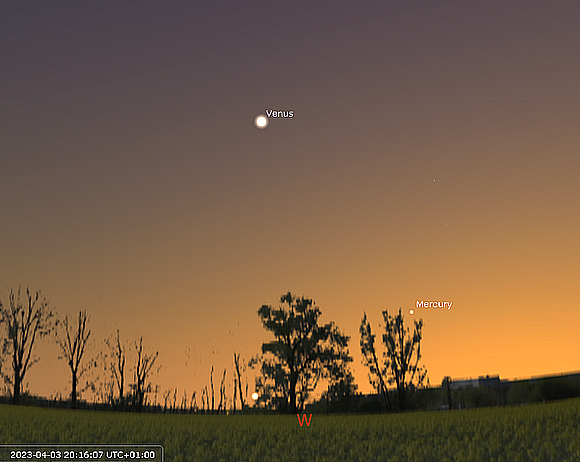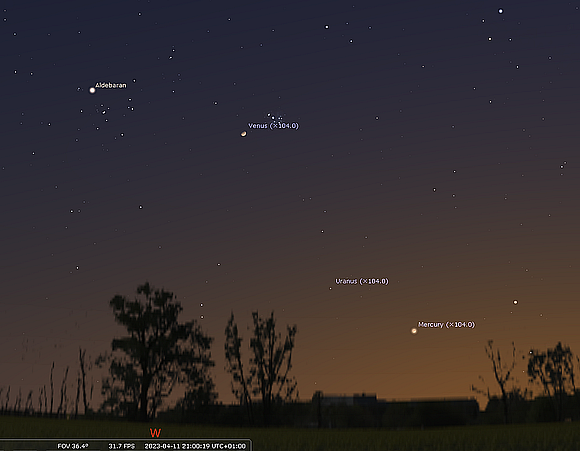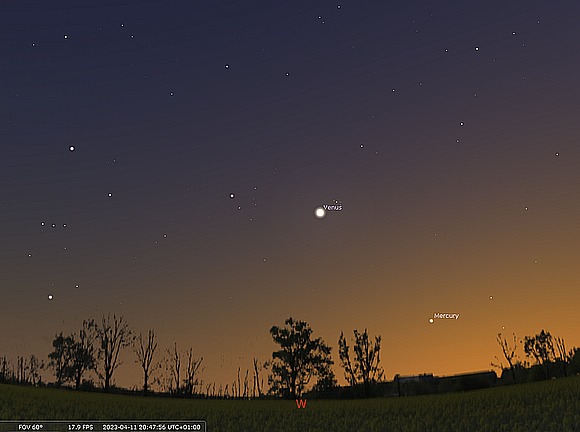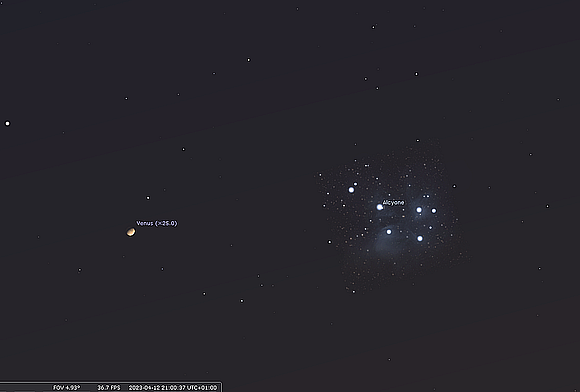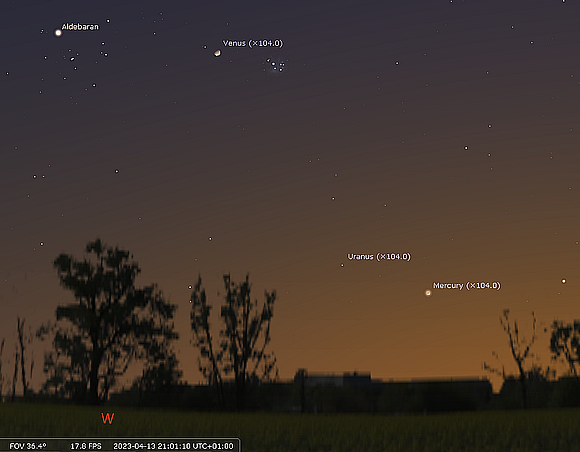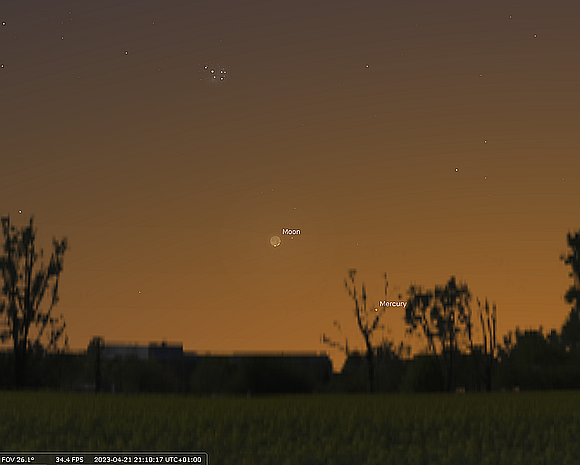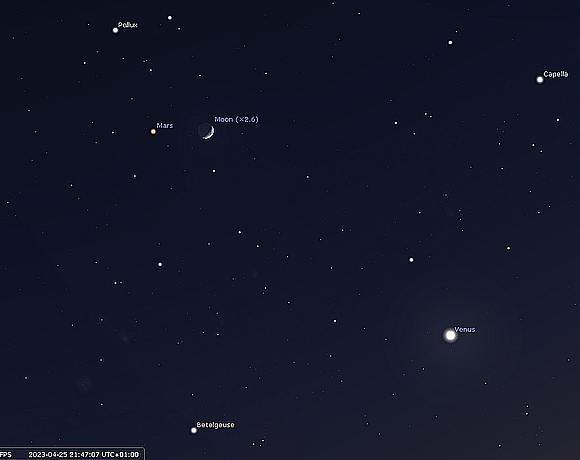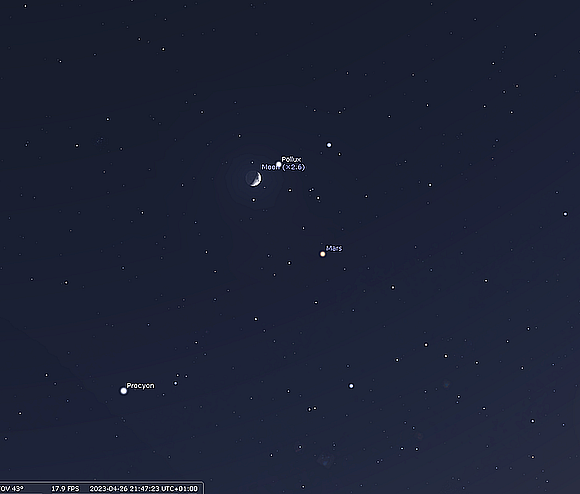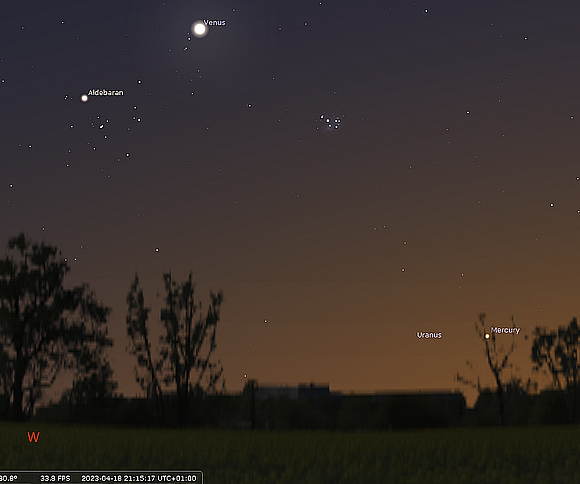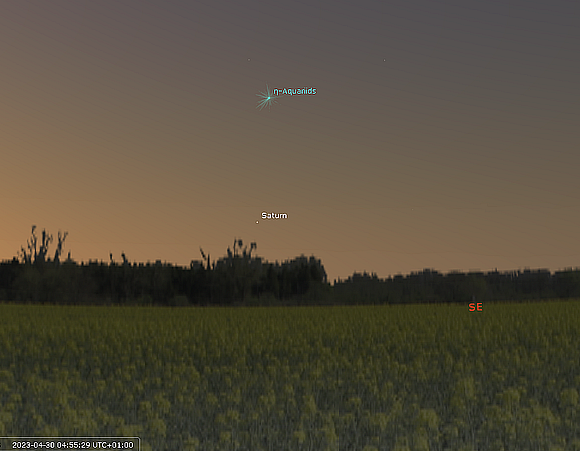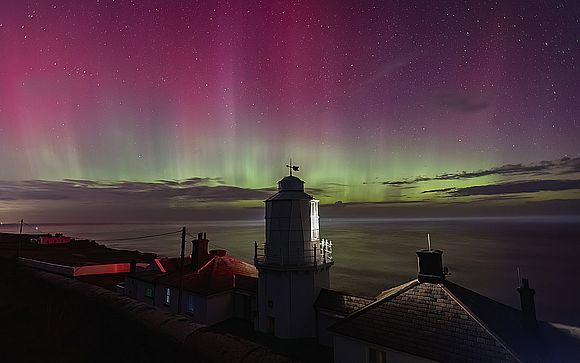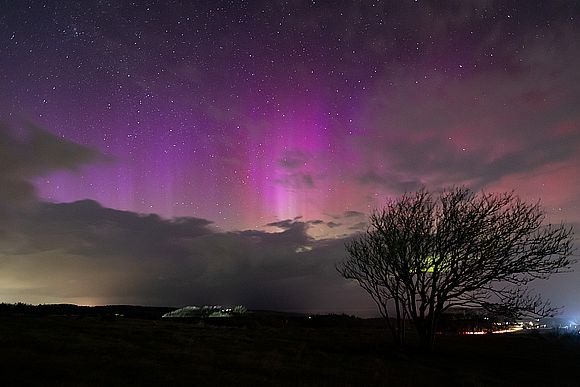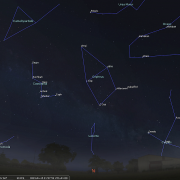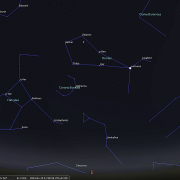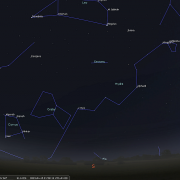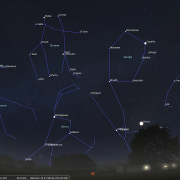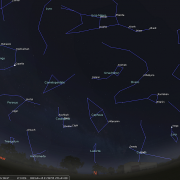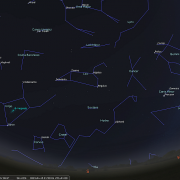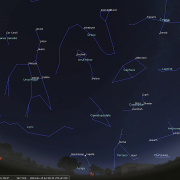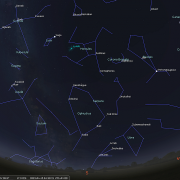In this month's Sky Notes:
Planetary Skylights: A Brief Guide to April's Night Sky
Jupiter is lost to the horizon; Venus rules the twilight sky. Mercury remains a viable naked eye target. Mars continues to slide down into the WNW. Saturn returns in dawn sky.
 Venus, the 'evening star', dominates the twilight sky up in the SW. Shining at mag -4.1, Venus becomes apparent less than a quarter of an hour after sunset, when it's the optimum time to observe. Its brilliance is then somewhat negated in the eyepiece, allowing the observer better definition of the gibbous phase Venus currently exhibits. At the start of April Venus is tracking up through the descending stars of Taurus due west, already at a very respectable 30-degree elevation. Venus attains its greatest height above the horizon around mid-month, blazing forth and turning heads in its direction. Over the course of several days starting on April 11th, watch Venus skirt by the lovely Pleiades star cluster - M45.
Venus, the 'evening star', dominates the twilight sky up in the SW. Shining at mag -4.1, Venus becomes apparent less than a quarter of an hour after sunset, when it's the optimum time to observe. Its brilliance is then somewhat negated in the eyepiece, allowing the observer better definition of the gibbous phase Venus currently exhibits. At the start of April Venus is tracking up through the descending stars of Taurus due west, already at a very respectable 30-degree elevation. Venus attains its greatest height above the horizon around mid-month, blazing forth and turning heads in its direction. Over the course of several days starting on April 11th, watch Venus skirt by the lovely Pleiades star cluster - M45.
This will be a wonderful opportunity for Astro photographers, or indeed anyone with a camera, phone, and a tripod. The conjunction with M45 is not very close, 2.5 degrees, but visually will appear very appealing to the eye or through binoculars. Venus has a further encounter, this one with a crescent Moon on April 23rd which lies 3 degrees above, some 25 degrees above the west horizon.
Venus is currently 175 million km distant from Earth, but over the course of April this reduces to 144 million Km. Aside from the phase, which is currently a waning gibbous, Venus offers very little else to note through the eyepiece, the surface constantly hidden by a thick duvet of cloud, although very occasionally darker patches are visible. By the end of the month the dazzling presence of Venus will remain on show well after 23:00hrs, quite unusual to view Venus in a true dark sky!
 Mercury continues its most favourable evening apparition of 2023 for Northern Hemisphere observers, reaching greatest eastern elongation from the Sun (19 degrees) on April 11th. The elusive messenger of the gods, and innermost planet to the Sun, is always a little tricky to view, but this month Mercury appears just about as far from the Suns glare as it can, considerably boosting the opportunity of tracking it down during the first half of April. At the start of April Mercury shines at magnitude -1.1 (Mercury always appears brightest at the start of evening apparitions and at the end of morning ones). Wait until 35 minutes after sunset before trying to locate Mercury which will reside around 9 degrees above the WNW horizon. A flat, unobstructed W horizon will therefore be helpful. The brilliant planet Venus sits approximately 21 degrees upper left of Mercury (a large hands span at arm's length). Mercury should be visible to the naked eye, but if conditions are still a little too light, use binoculars to pick it out of the twilight. As twilight deepens Mercury should become readily apparent.
Mercury continues its most favourable evening apparition of 2023 for Northern Hemisphere observers, reaching greatest eastern elongation from the Sun (19 degrees) on April 11th. The elusive messenger of the gods, and innermost planet to the Sun, is always a little tricky to view, but this month Mercury appears just about as far from the Suns glare as it can, considerably boosting the opportunity of tracking it down during the first half of April. At the start of April Mercury shines at magnitude -1.1 (Mercury always appears brightest at the start of evening apparitions and at the end of morning ones). Wait until 35 minutes after sunset before trying to locate Mercury which will reside around 9 degrees above the WNW horizon. A flat, unobstructed W horizon will therefore be helpful. The brilliant planet Venus sits approximately 21 degrees upper left of Mercury (a large hands span at arm's length). Mercury should be visible to the naked eye, but if conditions are still a little too light, use binoculars to pick it out of the twilight. As twilight deepens Mercury should become readily apparent.
Through the eyepiece Mercury will appear very small, but you may just discern the phase, this will change from a 6.0" arc second 77% gibbous disc at the start of April, to a 21% illuminated crescent of 9" arc seconds size by the end of the month. Observe as soon as Mercury becomes apparent, which like Venus is the optimum time to view. Unlike Venus, Mercury is not seen in a dark sky until just about to slip below the horizon. Mercury has a distant conjunction with faint Uranus on April 18th (see Uranus). On the 21st a crescent Moon resides upper left of Mercury, yet another pleasing vista.
 Mars remains a noticeable naked eye object tracking up through Gemini, passing just 0.2 degrees north of epsilon Gemini - Mebsuta. The Red Planet continues to diminish in brightness, ending the month at magnitude +1.3. appearing not dissimilar to nearby paler Pollux, one of the twins. The waxing crescent Moon lies nearby Mars on the 25th and 26th. Through the eyepiece Mars appears very small (just 7 arc seconds), with no detail visible, just a slight gibbous phase only. By the end of April, Mars will be dropping down into the West, but remains visible until midnight. It will continue linger in the evening sky for a few months yet.
Mars remains a noticeable naked eye object tracking up through Gemini, passing just 0.2 degrees north of epsilon Gemini - Mebsuta. The Red Planet continues to diminish in brightness, ending the month at magnitude +1.3. appearing not dissimilar to nearby paler Pollux, one of the twins. The waxing crescent Moon lies nearby Mars on the 25th and 26th. Through the eyepiece Mars appears very small (just 7 arc seconds), with no detail visible, just a slight gibbous phase only. By the end of April, Mars will be dropping down into the West, but remains visible until midnight. It will continue linger in the evening sky for a few months yet.
 Uranus becomes increasingly challenging to track down as we head through April, at which point Uranus becomes lost in solar glare. Before then however, Uranus has a distant conjunction with Mercury shortly after mid-month. The two planets will be separated by around 4 degrees from April 16th - 22nd, too wide for most telescopes, but a snug fit in a typical 10X50 binocular field. It is likely you will require binoculars to even spot Mercury, which will be a 2nd magnitude object by then. At magnitude +5.87 Uranus will definitely require optical aid, with a telescope of 75mm or 3" inch at medium magnification required to reveal the miniscule ghoulish grey/green disk just 3.6 arc seconds in diameter. Observe from 19:55 - 20:30hrs, by which time the planets will be just 3 degrees above the WNW horizon, the optimum time being around 20:10hrs when 6 degrees above the horizon. A very slim crescent Moon less than 2 days old sits 4 degrees above the two planets on April 21st, quite a challenging, but picturesque vista to capture.
Uranus becomes increasingly challenging to track down as we head through April, at which point Uranus becomes lost in solar glare. Before then however, Uranus has a distant conjunction with Mercury shortly after mid-month. The two planets will be separated by around 4 degrees from April 16th - 22nd, too wide for most telescopes, but a snug fit in a typical 10X50 binocular field. It is likely you will require binoculars to even spot Mercury, which will be a 2nd magnitude object by then. At magnitude +5.87 Uranus will definitely require optical aid, with a telescope of 75mm or 3" inch at medium magnification required to reveal the miniscule ghoulish grey/green disk just 3.6 arc seconds in diameter. Observe from 19:55 - 20:30hrs, by which time the planets will be just 3 degrees above the WNW horizon, the optimum time being around 20:10hrs when 6 degrees above the horizon. A very slim crescent Moon less than 2 days old sits 4 degrees above the two planets on April 21st, quite a challenging, but picturesque vista to capture.
 After being in solar conjunction for a few months Saturn emerges into the dawn sky at the very end of April. You will locate it just above the SE horizon around 04:55hrs in the dawn twilight. It will be naked eye or binocular object only for the time being.
After being in solar conjunction for a few months Saturn emerges into the dawn sky at the very end of April. You will locate it just above the SE horizon around 04:55hrs in the dawn twilight. It will be naked eye or binocular object only for the time being.
April Meteors... March Aurora
April sees a marked increase in meteor activity (albeit from a very low baseline) with several showers active during the month, although normally numbers are still modest. Let's start with what is regarded as the oldest observed meteor shower, the Lyrids (April 16-25th) with recorded sightings dating back 2,700 years to 687 BC by Chinese observers. The Lyrids are associated with the long periodic comet Thatcher (C/1861 G1), which makes a full orbit of the Sun once every 415 years and was last at perihelion in April 1861. Earth passes through fine debris left over from Comet Thatcher each April giving rise to the meteors. The shower peak normally falls on the 22nd/23rd. Ideal hourly rates can exceed 25, however actual observed rates will be substantially lower, perhaps 10-12 or so. The radiant resides upper right of the brilliant star Vega in Lyra, visible high to the east during the early morning hours, which is the optimum time to spot Lyrid meteors, with just the odd one witnessed pre-midnight. View at least a couple of hands spans away from Lyra. Early morning hours of the 23rd will yield best results, and with no moonlight to interfere, prospects are greatly enhanced. Lyrids can produce bright fireballs – so it’s worth keeping an eye out over the entire period.
Early in April a few Virginid meteors are likely, however numbers are barely more than sporadic levels; 4 or 5 per hour. Various radiants exist, but the one in April is reported to lie close to Gamma Virginis. Meteors belonging to this shower are normally slow, of long duration and can produce flared trails. Occasionally there are sporadic outbursts, with several tens per hour. The peak may be around April 12th, which does unfortunately coincide with strong Moonlight this year.
Finally, there have been a few displays of the aurora borealis - visible quite far south. As all too predictable much of the UK was clouded out for the first display, but a second, visible in the early hours of March 23rd and 24th was witnessed by some - including Richard Randle (see images below) Richard used a Canon EOS R6 with 16mm f2.8 lens, 5000th ISO and 6 second exposure. The first image was taken behind the lighthouse at Hawsker, the second one from Aislaby Hill top. Very nice indeed!
The aurora of March 23rd. Image - Richard Randle, taken from Aisalby Hill top.
(Click for large image)
April Night Sky
April has changed - I'm sticking my neck out a little here, but from a UK perspective the weather conditions experienced certainly have, and for the better I'm sad to say! Sad, because we can guess at the factors driving this change and they are not in our long term interests - or the planets. I recall many a dire, first full BST month over the years, and will go as far to say, April could seem the worst month of the year, cloudy, dull, and cold! April is now, from a factual - data based standpoint, and from my own experience, drier, warmer, sunnier, AND from an observer’s perspective, enjoys over 40% clearer night skies (expect biblical floods, blizzards, and fog now). One thing that doesn't change is the fact that evenings are rapidly becoming lighter in the northern hemisphere and by the end of the month can feel almost summer like in terms of light, shrinking the observing window to rather less than 5 hours. If the prospect of burning the observing midnight oil is not a problem, then April is a perfectly fine observers’ month, otherwise, make good use of any opportunities presenting themselves earlier on, when evenings are darker.
Following the change to BST, the night sky has a very different look to it. Seasonal winter constellations are slipping down to west horizon, their places supplanted by an ensemble of spring constellations. In the west, Taurus leads the entourage of Orion down to the horizon, with fiery Aldebaran - ‘the eye of the bull’, in the arrow shaped Hyades star cluster, pointing the way. It is however Orion himself, following his march across our skies, first to start slipping below the horizon. The hunter’s brightest star, blue-white Rigel, first to depart followed by the three belt stars, strung out in parallel above western horizon, before finally the ‘ruddy’ hue of Betelgeuse disappears.
The brightest star in the night sky, Sirius- the ‘dog star’ in Canes Major sparkles just above the SSW horizon, catching the eye - and the unwary, who sometimes mistake it for a UFO (yes, worrying isn’t it). Rest assured its alarming scintillation is purely down to our turbulent atmosphere. Somewhat higher in the SSW, look for solitary Procyon, chief star in the Lesser Dog of Canis Minor. Higher still in the west, the twins of Gemini descend feet first above Taurus, their heads marked by the stars, Castor and Pollux respectively. Of all the bright winter stars visible, only Capella in Auriga the charioteer, found high in the NW will remain, spending the summer months skirting above the north horizon. There are several planets visible in the west. Venus is obvious, exceedingly bright and cannot be mistaken for a star. Mercury is located lower right of Venus - a handful of degrees above the WNW horizon. Mars lies near the twins of Gemini.
By the time astronomical twilight commences, the remainder of the sky to the south and east can at first sight appear rather sparse. When compared to the majestic winter canopy fast disappearing into the afterglow. Like a great musical overture in which sometimes quieter interludes are played, so the spring sky could be likened to one of these. This is not to say there's nothing of interest to observe, far from it. Factually, there are more deep sky objects accessible to modest telescopes than in the winter sky, though perhaps not the variety, with many galaxies visible as fuzzy blobs.
Considered spring’s signature constellation, Leo is one of the most important constellations in the entire sky. The lion stands guarding his territory to the south, its head and mane marked by a distinctive stellar asterism known as the ‘sickle’ – the gardening implement which resembles a backwards question mark. At the base of this arrangement shines Leo’s chief star, Regulus, faintest of the 1st magnitude stars visible in the night sky. Regulus sits almost bang on the ecliptic and consequently is often involved in conjunctions with the Moon, sometimes being occulted by it, as well as being in conjunction with planets. In antiquity, from 4000 to 2000 BC Regulus was counted as one of the four Royal stars, those bright stars nearest the position of the equinoxes and solstices. During this period Regulus was closest to the summer solstice position, but over the millennia the effects of precession have moved this position away. The hindquarters of Leo are marked by a triangular arrangement of stars with the stars Denebola marking the rear point. Immediately below this triangle, and to the right, several small galaxy groups may be glimpsed. Behind Leo lie the smattering of stars marking Coma Berenices, a constellation rich in deep sky objects (galaxies mostly) including the Messier objects M53, (a globular cluster) M64, M85, M88, M91, M98, M99 and M100 (all galaxies) as well as coma galaxy cluster, some 300 million light year distant.
Ahead of Regulus, the faint stars of Cancer the Crab mark the forward boundary of those constellations associated with the spring section of the zodiac following after the twins of Gemini. The stars of the Crab may be faint, but the constellation contains the famous open cluster M44 - the Beehive or Preceipe. In antiquity the word 'Nebulous' specifically meant the Preceipe cluster. The cluster is visible to the naked eye as a hazy patch of light on clear, moonless nights and is a fine sight in a small telescope. Cancer also contains the distant open cluster M67 which resides near the southern border of Cancer, well below the Beehive.Below the Crab and the bright star Procyon in Canis Minor, note the knot of fainter stars that mark the head of Hydra - the Water Snake, largest constellation in the heavens. From this distinctive irregular loop, the snake slips downwards through its brightest star Alphard - ‘the solitary one’, located to the south, and slithers all the way to ESE horizon. The 'Water Snake' is such a large constellation, the tail stars are not fully visible above the SE horizon until the midnight hour!
Upon its sinuous coils ride two small, but quite distinct constellations, Crater the Cup and Corvus the Crow. You can locate both above the SSE horizon by 22:00hrs. The faint outline of Crater does indeed resemble a cup or goblet, whilst the outline of Corvus is that of a quadrilateral, sometimes referred to as Spica’s Spanker, a Spanker being a type of sail of very similar shape to Corvus. Spica resides upper left of Corvus and is the chief star in Virgo, visible low in the SE by 22:00hrs. Virgo occupies much of the southeast aspect, its outline suggests a bowl with a crooked leg (a bit like a distorted ‘Y’ pattern). Above the bowl of the 'Y' many galaxies belonging to the Virgo cluster can be identified in amateur scopes. The whole region of sky bounded by the 'bowl', Coma and the hindquarter of Leo is often referred to as the realm of the galaxies, being a window onto the wider universe, well away from intervening galactic gas and dust. Messier galaxies alnone within the constellation number 11; M49, M58, M59, M60, M61, M84, M86, M87, M89, M90 and M104 - the Sombrero galaxy.
Finally, look to the east to spy the lovely orange hue of Arcturus in the constellation of Bootes, which has returned after its short winter absence. After Sirius, Arcturus is the brightest star visible from the UK. Both it and Spica may also be located by using the pattern of the Plough, found high up in the NE. Simply follow the curve of the handle round and continue this trajectory to Arcturus. From there project a line to the SE, and bingo, you have Spica. So remember from the Plough ‘arc to Arcturus , then speed on to Spica’. It’s plain sailing really!
April Sky Charts.
Additional Image Credits:
- Planets and Comets where not otherwise mentioned: NASA
- Sky Charts: Stellarium Software and Starry Night Pro Plus 8
- Log in to post comments

